The Amateur Mycologist #36 - How To Turn Your Christmas Tree Into Food, Part 1 - Growing Choice Edible Mushrooms And The Biology Behind Log Inoculation
This particular mini-series DOES mention edible fungi, because the goal is to learn how to make fungus grow out of your Christmas tree. However, a few things should be kept in mind. First, I've only successfully inoculated a log once, and it was only a partial success. Second, attempting to grow mushrooms, even known, edible mushrooms, out of a log can still have unsafe results. If you are unsuccessful at growing the selected mushroom, inedible wild mushrooms can take over your log and grow instead. Additionally, failed grows can sometimes result in mold growth, which can also be dangerous to ingest. Finally, even if you successfully grow your chosen species, you may still have a personal allergic reaction to that species, or a reaction to specific toxins in the specific log you used.
My only point is that no process, however careful you are, is 100% free of risk, especially when it comes to growing or eating mushrooms. If you choose to try to grow mushrooms from logs, of course, as always, you do so at your own risk. If you're interested in doing so, I would suggest reading up in other sources as well, including Fungi Perfecti's website, or one of the many books on this awesome and rewarding topic.
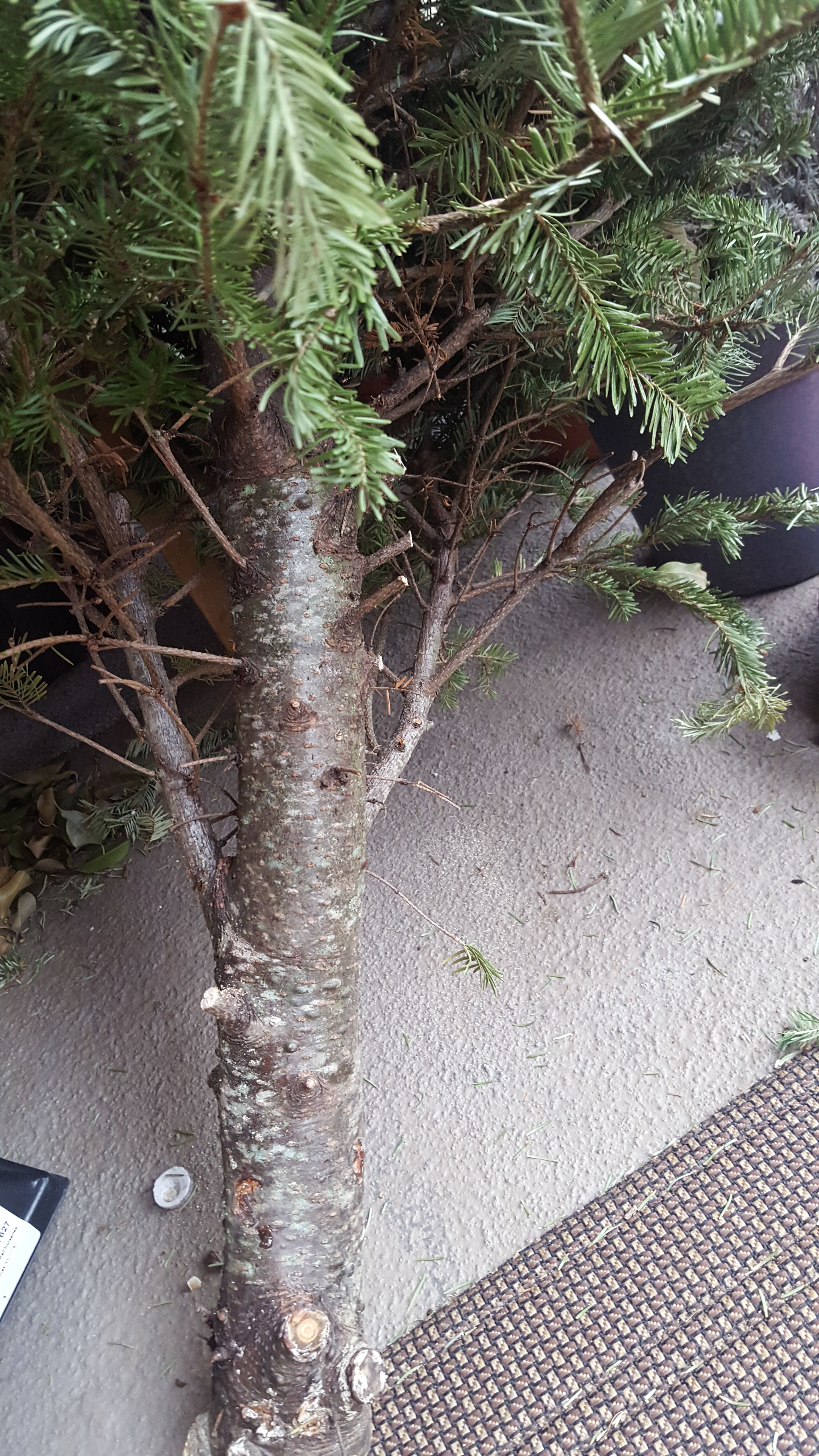
I hate wasting resources.
As a modern city dweller, I inevitably end up doing just that. This manifests in lots of small ways - forgetting about food in the refrigerator, not maintaining a compost bin, or using too much water or paper products, just to name a few.
But one form of waste has always been particularly irksome to me - Christmas trees. The whole idea of a Christmas tree is baffling in the modern age. It made sense in the past, when there were fewer people living on large plots of land with tons of small to middling conifers naturally growing everywhere. And, for those of you living that kind of lifestyle, in that kind of location, perhaps it still makes sense.
However, for city dwellers like myself, why are Christmas trees still a thing? They have to be farmed, for years, just to be cut down and then shipped via rail and truck hundreds of miles into the cities, only to be sold to customers who will care for them for two months, max - temporarily increasing their overall risk of fire - and then dump them in the garbage. How does that make any sense?
Those of you who live in a big city like New York will be all to familiar with the post-Christmas tree graveyards lining every city street. The municipal garbage services have to work overtime to pick them all up - which means running more large trucks in and out of cities to various dump sites or incinerators. Best case scenario Christmas trees are carbon neutral, but I doubt it. Overall they're a frivolous waste of money and resources.
However, I know lots of people do buy Christmas trees, and so I wanted to see if there was some better use you could put them to beyond simply dropping them curbside.
For homesteaders, or just folks with homes, you could do a bunch of things with your tree - including chipping it or simply leaving it in a pile with other woody debris and letting it biodegrade. For us city folk, there are fewer options.
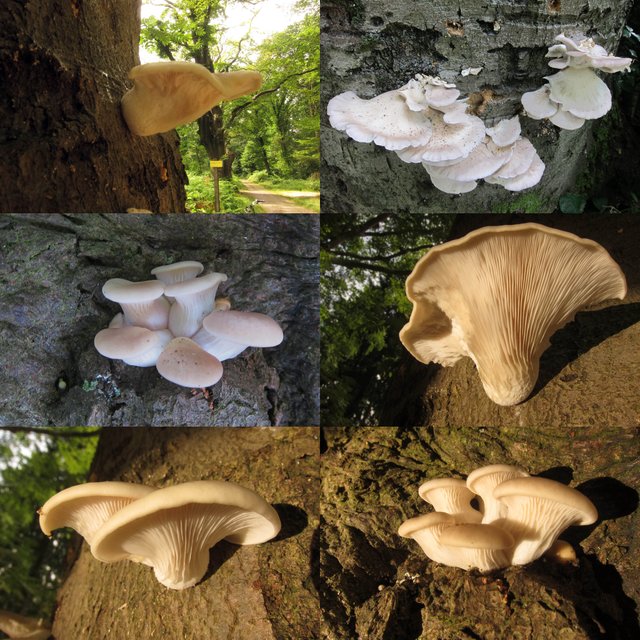
However, if you have a balcony, backyard, or fire escape, one viable option for the city dweller is to turn your Christmas tree into food!
In my writing on fungus so far, we have discussed finding wild mushrooms and growing fungi and slime molds in petri dishes on a small scale. But today we begin a very different process - growing edible mushrooms on a scale we can actually gastronomically enjoy.
In today's post we'll go over the biology of how you can turn your Christmas tree, fairly reliably, into a known edible mushroom. Next time we'll talk about what materials you need, where to get it all, and how to prepare it for inoculation. Finally we will go through the inoculating process step-by-step. Then, months from now, we'll check in and see how they're doing - and hopefully get a "flush" of Phoenix Oysters we can harvest.
Let's get started!
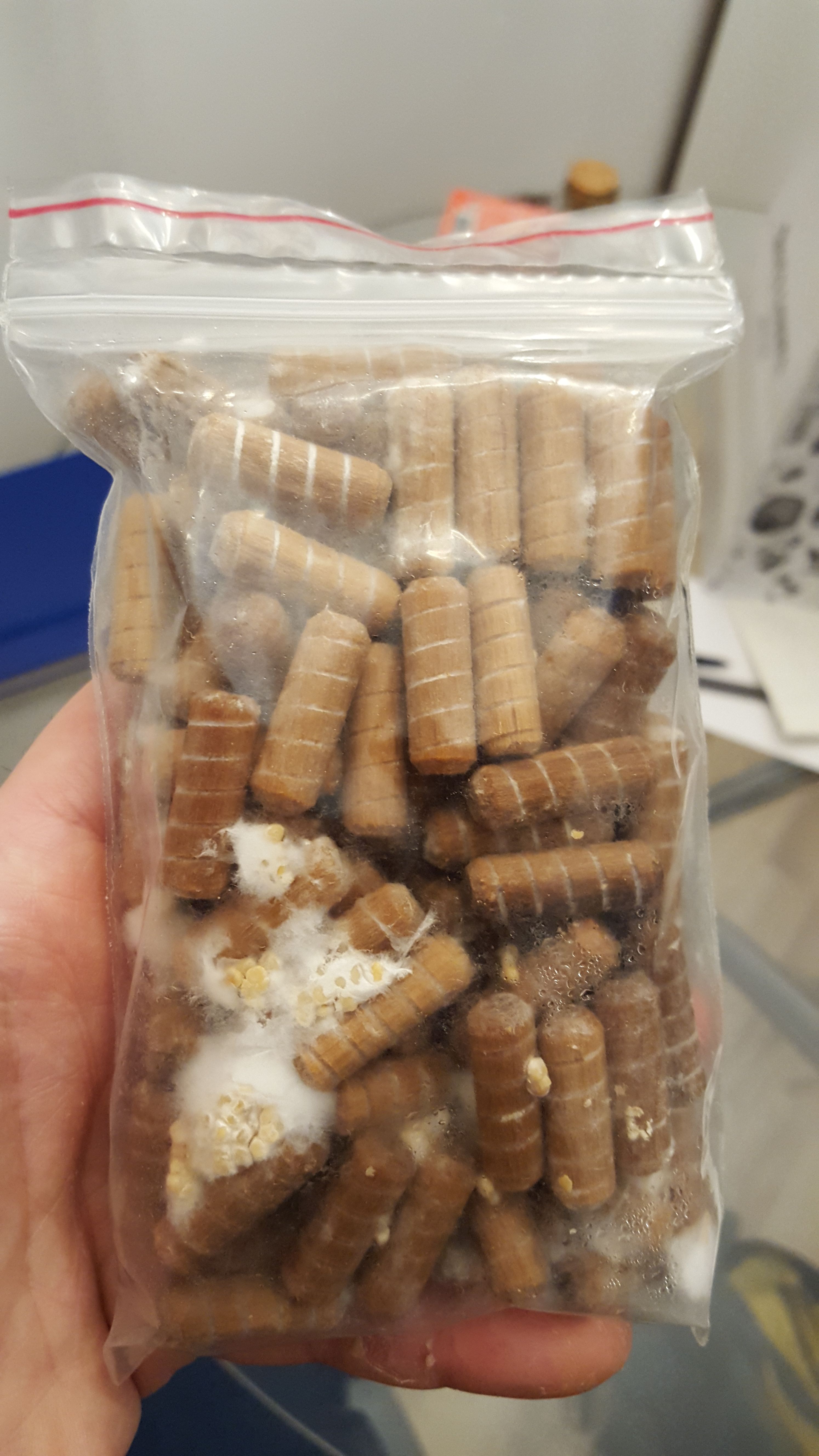
These wooden dowels partially covered in healthy fungal mycelium are the key to the whole process.
What do we mean when we say we are going to "inoculate" a log? It means we are going to take the nutritional medium that is the log and expose it to the mycelium of the species of mushroom we want to grow out of the log.
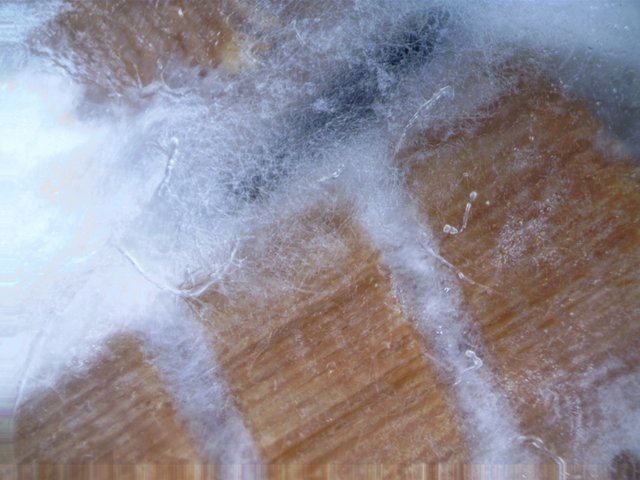
In order to understand this, we need too remember what a fungus is, and how it works.
We must remember that the fruiting body of the mushroom is not the entire fungal organism. When we talk about most fungal species, the majority of the organism is the white stuff you see in the photo to the left - the mycelium. It is the mycelium which usually constitutes the bulk of the fungus. And, in order to get a specific species of mushroom to pop out of a log, we need to arrange it so that only the mycelium of the species we want takes over the log.
But how do mushrooms take over a log in the first place?
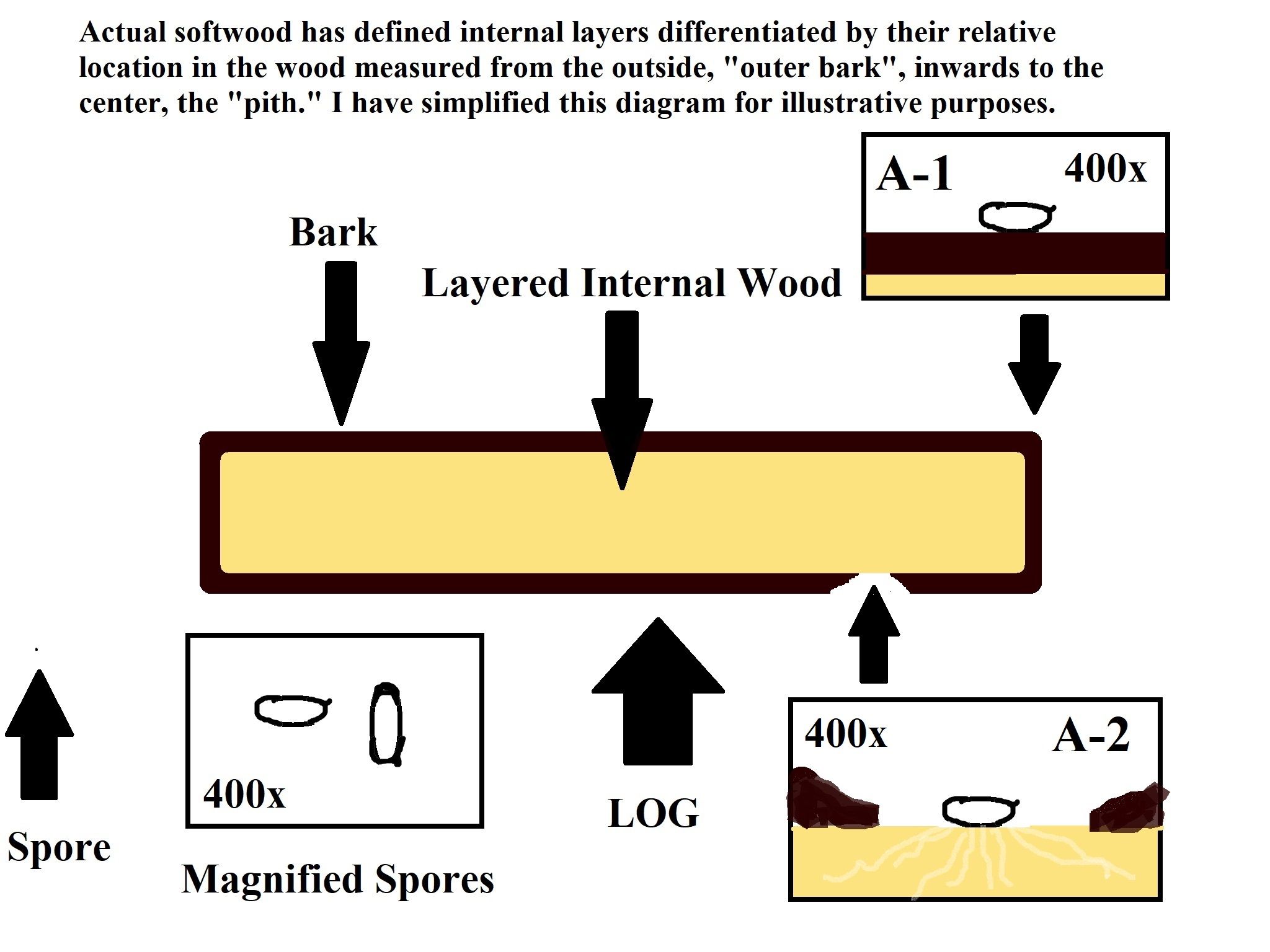
1) How fungi grow in nature.
Left to their own devices, mushrooms release spores, which are then dispersed into the surrounding area in the hopes of finding an appropriate growth medium to thrive on.
Fungal spores can be either asexual genetic clones of the original fungus or, through sexual reproduction, contain a mixture of DNA from two different fungal specimens. In either case, once the spores are produced and released, they are capable of germinating if they find their way to favorable conditions.
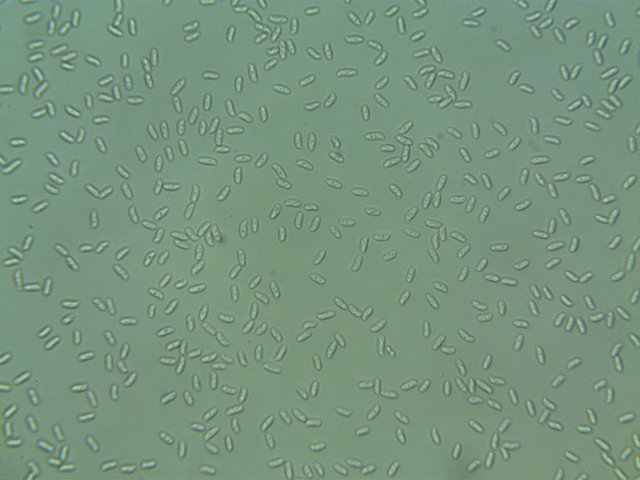
For saprobic mushrooms - mushrooms which live on and derive nutrients from dead organic matter - the "favorable conditions" are often moist pieces of dead wood. If the spore lands on the external bark of newly dead wood, it may have trouble germinating. (See A-1 Above).
However, if the spore gets lucky and falls in a crack in the bark, landing on the less fungally resistant internal wood, then the spore may germinate, forming tiny hyphae - or the individual white threads which make up the fluffy white mycelium you see in the photos above. (See A-2 Above)
After the spore germinates and begins creating hyphae, the hyphae will attempt to grow into the wood. They do this by harvesting nitrogen, carbon and other nutrients from the wood itself. This is primarily achieved by releasing lignin destroying enzymes, like laccase, and then absorbing the newly released nutrients directly. Those nutrients are then transported across the mycelium to help the whole structure grow. This creates more hyphae, which harvests more nutrients, which creates more hyphae, so on and so forth.
Once the mycelium has grown large enough and strong enough, and collected enough of the available nutrients from the growth medium it's found itself on, it eventually decides the time has come to try and procreate. It is at this point, fairly far along in the development and life cycle of the fungal lifeform, that the mycelium produces the archetypal "mushrooms" we are all familiar with. Those mushrooms will mature and produce spores of their own, beginning the life cycle again.
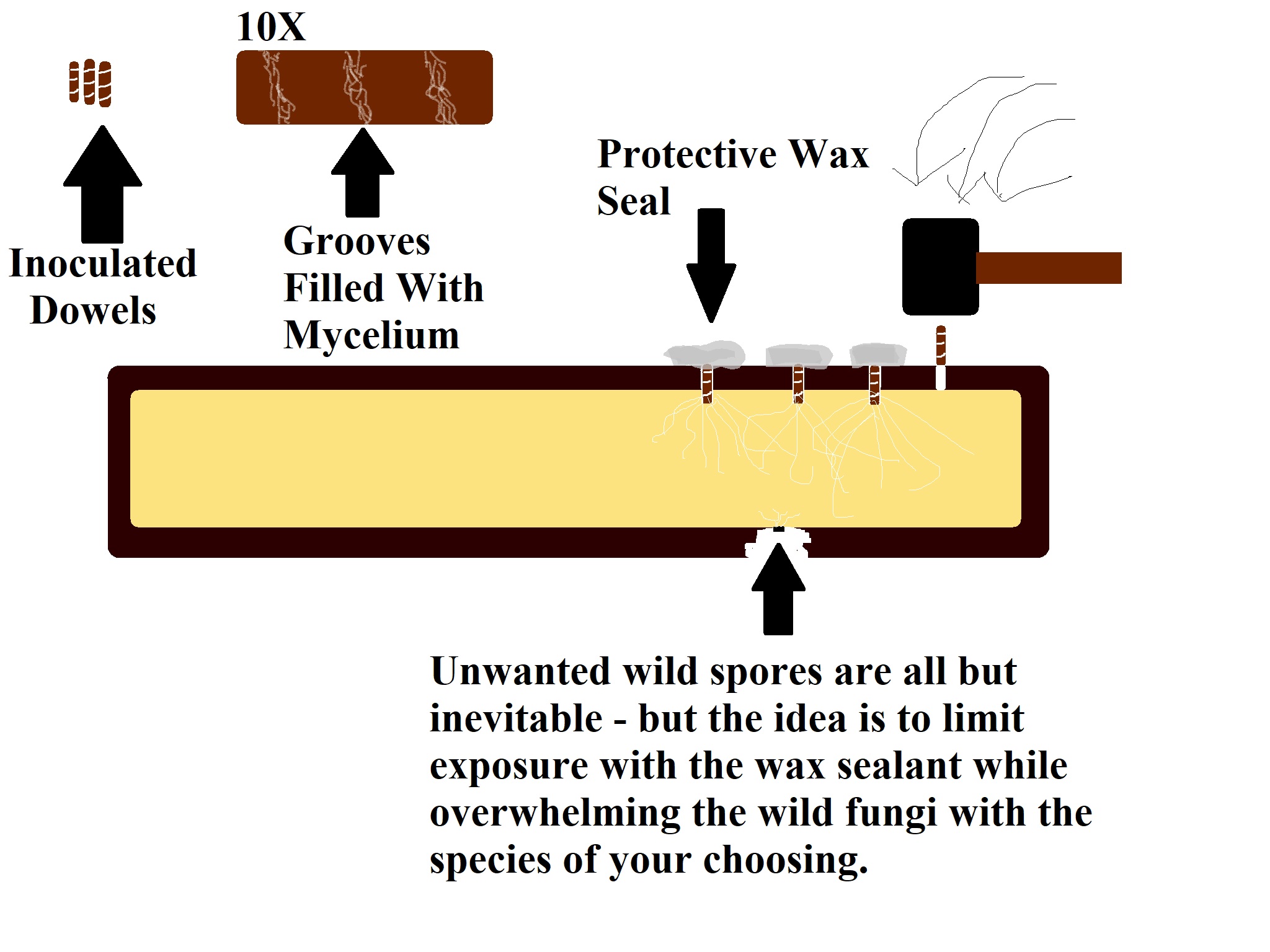
2) How we will grow a chosen fungi from a Christmas tree.
The goal in inoculating a log is to super charge the natural process by which a fungal organism takes over a growth medium by giving a specific fungus a giant head start.
We achieve this by skipping the germination stage entirely, getting rid of most of the chance involved, and inserting pre-formed mycelium directly into the wood. This is the "inoculation". That inoculated log, filled with pre-grown mycelium, is then kept in a shaded place, and kept moist, either by rain or by our watering, until the mycelium takes over the entire log and is ready to grow fruiting bodies.
3) Where do we get that pre-grown mycelium from?
Well, the simplest thing to do is to buy them online from a reputable seller. For my money, that's the good folks at Fungi Perfecti, including the renowned mycologist Paul Stamets. They sell the mycelium covered wooden dowels you can see in the picture near the top of this post. (The astute observer may also note that the mycelium is not quite as well developed in that photo as we'd like - a problem which will be addressed on Friday.)
You can technically grow mycelium, and mushrooms, directly from spore at home by buying - or harvesting - the spores of a known mushroom and inoculating a compatible, pasteurized growth medium with said spores. We will be trying to do just that in the future.However, this is an advanced process that I have not even attempted yet, and which is rife with potential errors, some of which can be quite dangerous.
It's much simpler, and probably safer, to begin your mushroom growing experience with pre-inoculated dowels.
As my second totally professional looking (:P) illustrative diagram shows, we will be taking the mycelium covered dowels, drilling dowel sized holes in the log, and then malleting the dowels into the holes. Then, we will use melted bee's or soy wax to seal the dowel filled hole from the outside. The purpose of the seal is to prevent naturally occurring spores from taking advantage of the barkless area we've just created.
The goal at all times during this process is to try to limit the amount of wild spores that get into the wood, while maximizing the the conditions necessary for the chosen mycelium to propagate.
There are several other factors to be aware of before embarking on this process.
You need to know the type of wood you're using and which species are compatible with it. Some species can grow on almost anything - like Turkey Tails for instance - while other species can be very picky. Meanwhile, some types of wood can be receptive to most fungi, while others - like cherry wood - are damn near impossible to inoculate with anything. I have made three attempts at log inoculation in the past. The first failed because I did not understand this relationship between the species and the wood. Thankfully, Fungi Perfecti provides a helpful graph to match the right species with the right wood.
The quality of the log matters. When I say the "quality" of the log, I'm talking about its size and the state of its external bark. Most sources will say the log should be 4 inches in diameter at a minimum, and 2-4 feet long - but it can be as wide as a tree stump if you do it right. Moreover, ideally the external bark should be unbroken at the time that you drill into the log to put in the dowels. If you use a thinner log, or a log with pre-broken bark, you could end up with competing fungi inside the log, which might reduce, or eliminate, your final harvest of the mushroom you actually want. Plus, if a lot of bark is missing, the log may not retain enough moisture for the mycelium to thrive. When it comes to turning your - or a stranger's - Christmas tree into food, thicker logs are better, as is more intact bark.
The age of the log matters. When I say age here, I mean the time since the log died. In the case of a log cut off a healthy tree, the age would be calculated from the moment the log was cut. Fungi perfecti suggests waiting 2-3 weeks before inoculating a freshly cut log. This is because the fresh cut log retains many of the anti-fungal properties that living trees naturally developed to prevent being killed by fungi. The 2-3 week waiting period is basically letting the log well and truly die. However, you don't want to wait too long either - the longer you leave the log outside, the higher the chance naturally occurring fungal spores take over. Lastly, you don't want to use a log from an already fungally infested tree.
You want to inoculate at the right time, for the right species. Fungi Perfecti has a helpful chart addressing this issue as well for the continental United States..
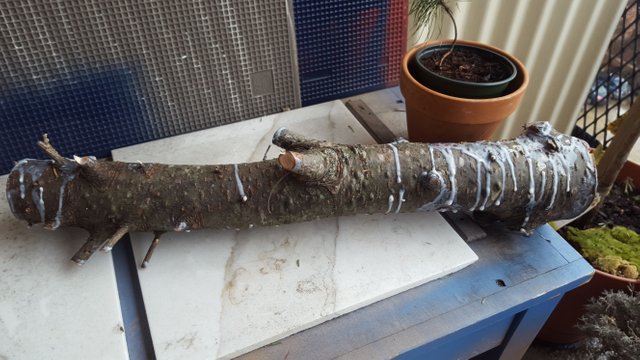
In summary...
In nature, fungal spores spread at random, get lucky, and germinate on a piece of wood. Here, we are going to insert pre-developed mycelium directly into the interior wood of a log, giving it a major head start over naturally occurring spores. By choosing the right combination of wood and fungus, in the right piece of wood, at roughly the right time, in roughly the right way, we should be able to maximize the chances of our chosen species taking over the entire log and eventually growing mushrooms we can eat from it.
The photo above is our prepped Christmas tree log. It is too small, and too thin, and missing some bark. However, we will be using Phoenix oyster mycelium, Pleurotus pulmonariusare, which are fairly aggressive and robust. I'm hoping we should still get something out of it, as a proof of concept. Unfortunately, I didn't buy a Christmas tree this year, and this was the thickest log I could find within dragging distance on my block. (Not Kidding).
However, if you live in the suburbs you can go around weirding out your neighbors in search of the X-Christmas tree cream of the crop.
Friday we will go into Part II, and discuss where to buy the raw materials - besides the Christmas tree - and how to prepare them before the inoculation takes place.
Edit: Full disclosure - although I tend not to use upvote services on my full Amateur Mycologist posts, as they are very niche and tend to receive ample support, I also want to try and expand my readership and visibility a bit. I think this particular topic is a good one to introduce new readers to my blog, and so I'm going to be paying for some early, fairly large service upvotes on this and the other posts in this mini series. Having said that I want to be upfront about it. In general I reserve upvote services for my smaller posts - individual pictures and stories.
Edit2: Lol - not that big... OK - I think I am going to save up and try to force one post to trending... It might be the final part of this series, with links to the other parts
Photos And Videos Are My Own Except:
[2]Henk Monster [CC BY 3.0 (http://creativecommons.org/licenses/by/3.0)], via Wikimedia Commons
Microscopic photos were taken using an AmScope SM-4TZ-144A dissecting microscope and an AMScope M150B entry level microscope. The camera lens is also AMScope, MU300.
Information Sources
[1]Kuo, M. (2017, December). Pleurotus pulmonarius. Retrieved from the MushroomExpert.Com
[2]Wikipedia on P.pulmonarius
glandulosa.
[3]Where to buy plug spawn at Fungi Perfecti
[4]Mushrooms of the Northeastern United States and Eastern Canada by Timothy J Baroni, p.210, P.pulmonarius
[5]Cool Lumenlearning Course on Fungi Basics
Being A SteemStem Member
WOW! what an awesome idea! I generally plant a coniferous seedling in a pot and let it get big for a while to be my Christmas tree and then plant it after a couple of years. BUT I do want to grow my own mushrooms as they are not easy to find where I live and if I do find them they are super expensive. Thanks for sharing your experiment.
That's the great thing - you can keep doing what you've been doing with your christmas tree tradition and still use the discardwd trees of others - i want to find out where nyc disposes of their christmas trees and just head down there with a hacksaw
Will be posting tomorrow about what you need and how to prep - the actual inoculation will come soon thereafter
Very good publication, I hope to continue reading articles like these.
My goodness. I wish I know this earlier!
There are many more Christmas's to come - and countless discarded trees to use as a subtrate :)
Nice post
Growing your own mushrooms on the farm is a very rewarding thing.
I can only imagine - if i had access to my own woodlands and space, I would have a veritable mushroom farm at this point with choice edible logs galore!
One of my favorite activities! I've inoculated oyster and shitake, never knew oyster favored some conifers. Thanks for spreading the knowledge, growing your own food is empowering!
Be careful - most Oysters do not thrive on conifers - it's only phoenix oysters that do - and I think there might even be some breeding that fungi perfecti has done to make a particularly confifer friendly variant.
Woah, interesting! Would have never guessed, I really want to try out reishi and other more difficult varieties in the future.
Stamet's company has a ton of species available
Awesome! Been a fan if Paul for a while might as well support him though his products! Resteemed!
Cool! Reduce, reuse, recycle, and eat your mushrooms!
That's the plan!
it's a very brilliant idea to practice.
I just found out that the wood is useful.
really great for you in this.
thank you very good information. @dber
Glad to see you supporting Paul Stamets, he is a living treasure.
He's awesome and fungi perfecti is my go to for dowels and spores.
Is amazing you know so much things. You are really passionate :)